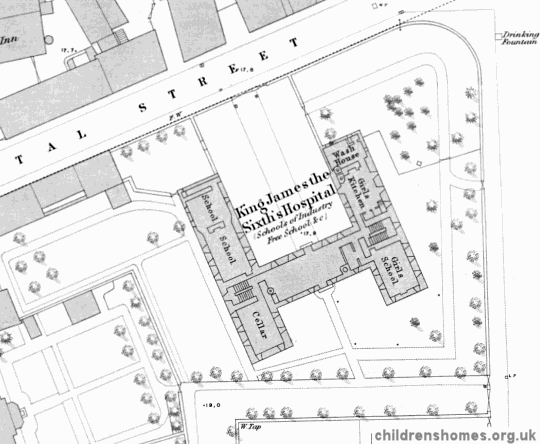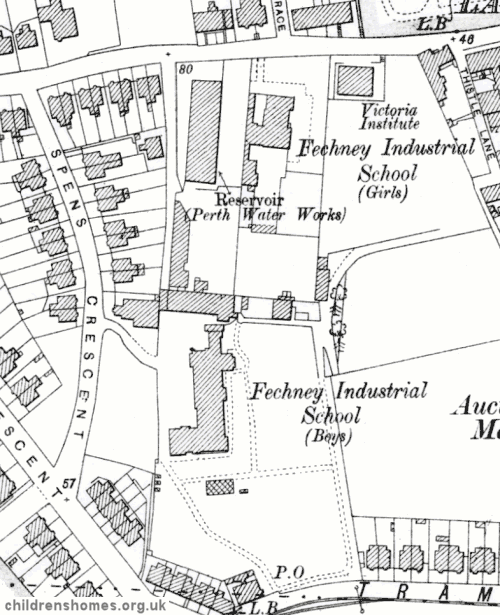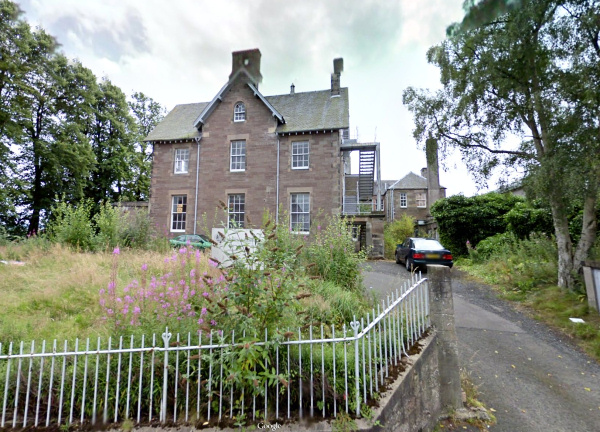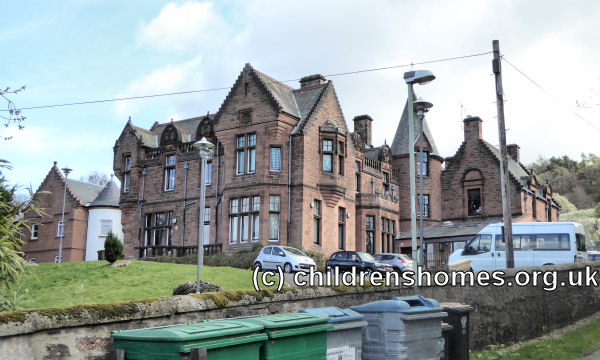Girls' School of Industry / Wellshill School / Balnacraig School, Perth, Perthshire, Scotland
A meeting took place in Perth City Hall on 19 May 1842 at which a committee was formed to pursue the establishment of a School of Industry in order to check the increase in juvenile delinquency. By the end of the year, accommodation for the institution had provided in part of the King James VI Hospital, on Hospital Street in the centre of Perth. The Boys' School of Industry received its first inmates on 1 January 1843.
Later the same year, plans for a girls' establishment were upset by the Disruption — a schism in the established Church of Scotland which led to the formation of the breakaway Free Church. As a result, supporters of the breakaway movement set up their own institution which became known as the Ladies' House of Refuge. By the end of 1843, however, the Girls' School of Industry (also known as the Female School of Industry) had opened in its own section of the Hospital building. Its object was 'to withdraw the poor from contaminating example, and to inculcate in them the principles of religion and the habits of industry.' In November 1844, the school had 14 pupils.
The School site is shown on the 1860 map below.

Boys' School of Industry site, Perth, c.1860.
On 23 December 1854, the girls' department was formally certified under Dunlop's Act to operate as a Reformatory. Initially, the school seems to have been little used by magistrates — in October 1858, only one girls was there under a court order. In around 1862, the establishment was redesignated as an Industrial School, which led to an increase in committals. In November 1862, 24 of the 51 girls were under detention. As well as their classroom education, the girls were employed in needlework, knitting and housework.
In April 1864, the boys' department was transferred to a new building at Wells Hill, which became known as the Fechney Industrial School. The girls' school continued in operation at Hospital Street, where the superintendent was now Miss McLagan.
On June 7 1870, the girls were transferred to their own new premises, adjacent to the boys' school at Wells Hill (or Wellshill), Perth, Perthshire. Accommodation was provided for up to 60 girls, aged from 7 to 10 years at their date of admission. The new site included a good garden and a large playground. Coinciding with the move, Miss Welsh (or Welch) succeeded Miss McLagan as superintendent. Miss Telford was assistant matron.
The Wells Hill site is shown on the 1900 map below.

Wells Hill Industrial Schools site, Perth, c.1900.

Former Girls' Industrial School from the north, Perth.
As before, the girls were prepared for domestic service and their industrial occupations consisted of sewing, knitting and household work. They also did the washing for the establishment. The rota of employment was frequently changed so that all the girls had their share in the various duties.
In August 1876, fever of a typhoid character broke out and by the beginning of November there had been fifty cases, including Miss Moir, the teacher, who subsequently felt obliged to resign from her position. Although the infection was severe, no deaths occurred. Defects in the drainage, largely owing to the unusual dryness of the season, and a want of water, were blamed for the outbreak.
After nine years as superintendent, Miss Welsh retired in 1879 and was succeeded by Miss E. McKenzie, formerly the sewing mistress.
In 1880-81, additions were made to the buildings including a new dormitory with a teacher's room, a staircase providing an additional means of escape in case of fire, and a new lavatory.
In 1882, it was reported that every Sunday evening, a bible class was held for young girls who had left the school and were serving in the neighbourhood. There was also an annual 'festival' to which old girls were encouraged to come.
A new playshed was erected in 1883. The girls were now said t make all their own clothes. An outside teacher attended regularly to teach the girls singing. ark green blinds were put up in all the dormitories for the prevention of ophthalmia. Marks were awarded for schoolroom work, which led to prizes in money and books. The money was put into the Perth Savings Bank. Twenty-five of the girls had bank books, with sums to their credit of up to thirty shillings. The schoolmistress, Miss McGillivray, had a certificate from the School of Cookery, and gave practical lessons to the senior girls.
In 1886, Since a new lavatory, bathroom and dairy were added.
In 1887, two of the girls emigrated to Manitoba, and one to New Brunswick. That year also saw the departure of the superintendent, Miss McKenzie. Charge was briefly taken by Miss Rough, who was succeeded by Mrs Carter. The changes in staff led to a period of unsettlement among the girls and many cases of petty theft, disorder, untruthfulness, and some instances of stubbornness and refusal to work. In one case, a straw bed had been set on fire.
Further building work in 1891 added a new laundry, washing-house, bathroom, play-room, and a sick-room with nurses' room, bathroom and lavatory. Miss Houston was superintendent but by 1893 had been succeeded by Miss Gray.
An inspection report in 1896 recorded 39 girls in the school, with one voluntary case and four out on licence. In the classroom, recitation, history, object lessons and singing (tonic sol-fa) were all rated 'very fair'. The usual allocation of girls to the various industrial occupations was: 5 in laundry work, 40 in housework, and 12 in cookery. A drill sergeant visited once a week to instruct the girls in dumb-bell and other exercises. The girls went for a walk every Saturday, and more frequently in the summer. A annual day-trip was made to Broughty Ferry, where boating and other amusements were enjoyed. On this occasion, the girls were allowed to spend a portion of their savings in the school bank. Each girl a play-box in which she was allowed to keep knick-knacks. The school took part in a concert at the town hall each year, besides having a Christmas tree and an annual festival.
From 1900 onwards, the girls had an annual holiday in the countryside, with Glenfarg becoming the usual destination.
An Auxiliary Home in connection with the school was opened in November 1903 at 59 North Methven Street. It provided temporary accommodation for up to six 'old girls' who were leaving the school or between situations. It continued in use until 1927 when it was replaced by a building in the school grounds.
In January 1906, Miss Gray retired as superintendent but took over charge of the Auxiliary Home. She was succeeded by Miss J.S. Reid who had previously been assistant matron.
The 1911 inspection recorded 59 girls in the school, including five voluntary case and one on licence. Industrial training included cutting-out and use of a sewing machine. Lessons in domestic economy and household account were given in the school room. Swedish drill was taken each morning in the playground, and Morris and other dances had been introduced. Walks were taken regularly, and the younger girls were sent out daily into the town. A lady of the committee took classes at the school on Sundays. An month's holiday had again been spent at Glenfarg in the summer. At the old girls' reunion, held in the winter, 57 old girls attended. Several spent the weekend at the school or at the Auxiliary Home.
After the closure of the adjacent Fechney Industrial School for Boys in 1922, its premises were incorporated into the girls' site. Girls from the Perth Ladies House of Refuge at Craigie, was also closed at this time, and its inmates were transfererd to Wellshill. Some of the girls began to attend local outside schools.
In around 1933, the girls' establishment, now known as Wellshill Girls' School, became one of the new Approved Schools introduced by the Children and Young Persons (Scotland) Act to replace the existing system of Reformatory and Industrial Schools. In its new role, the school housed up to 60 girls aged from 7 to 10 years at their date of admission.
In 1943, the headmistress was Mrs B. Reid. Practical instruction at this date included cookery, laundrywork, dressmaking and housewifery.
In 1948, the managers of the school purchased a large house known as Balnacraig on Fairmount Terrace, Perth, which was to become the school's new home. Balnacraig School, as it was now known, was certified to begin operation on 7 August 1950, with the Wellshill site formally closing on 31 January 1951.

Former Balnacraig Approved School, Perth, 2017. © Peter Higginbotham

Former Balnacraig Approved School, Perth, 2017. © Peter Higginbotham
Following Scotland's 1968 Social Work Act, Balnacraig became a 'List D' School for Junior Girls.
In 1986, Balnacraig became an independent residential school. Three years later, boys were admitted for the first time. The school continues today with pupils from 11 to 18 years of age who are in need of additional learning support due to emotional, social or behavioural issues.
The Wellshill site was later used as government offices. All the old buildings were demolished in 2012.
Records
Note: many repositories impose a closure period of up to 100 years for records identifying individuals. Before travelling a long distance, always check that the records you want to consult will be available.
- Balnacraig School, Fairmount Terrace, Perth PH2 7AR.
Census
Bibliography
- Higginbotham, Peter Children's Homes: A History of Institutional Care for Britain's Young (2017, Pen & Sword)
- Mahood, Linda Policing Gender, Class and Family: Britain, 1850-1940 (1995, Univeristy of Alberta Press)
- Prahms, Wendy Newcastle Ragged and Industrial School (2006, The History Press)
Links
Except where indicated, this page () © Peter Higginbotham. Contents may not be reproduced without permission.


